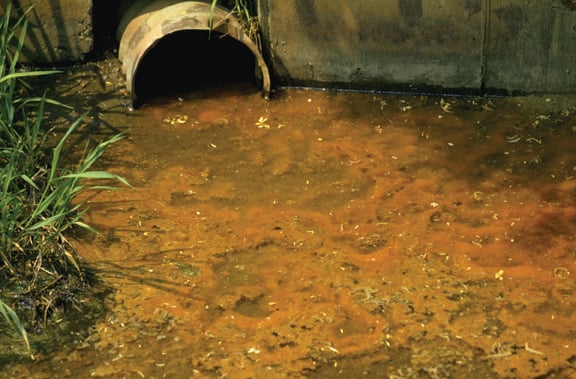Since the 1970s, scientists have analyzed lake sediment and ice cores to understand the levels of historical atmospheric mercury emissions from metal production and industrial activity. Much of the published ice core mercury record has come from a glacier in Wyoming. While the record has been cited extensively in scientific literature, many modern day scientist argue that it does not truly represent the global trends in atmospheric mercury levels.
Read MoreTeledyne Leeman Labs Blog
Tags: Hg analysis
Mistake leads to need for Mercury level analysis in river
Posted by Betsey Seibel on Sep 25, 2015 12:53:48 PM
The Animas River is a 125-mile river in the western United States that feeds the Colorado River. On August 5, 2015, a crew from the U.S. Environmental Protection Agency (EPA) was pumping out water from the abandoned Gold King Mine in Southern Colorado when heavy equipment used by the workers caused a leak.
Read MoreTags: Hg analysis
When researchers began analyzing fish off of the coasts of Hawaii for mercury contamination, they discovered an alarming trend. In a study published in the journal, Environmental Toxicology & Chemistry, researchers found that levels of mercury are rising at roughly 4 percent per year in commercially captured fish, particularly tuna. The data suggests that the mercury levels are rising because of human activity, and at this current rate, mercury concentrations off the coast of the North Pacific could double by 2050.
In a statement, the lead author of the study, Paul Drevnick, from the University of Michigan Biological Station and School of Natural Resources and Environment, said, “The take-home message is that mercury in tuna appears to be increasing in lock-step with data and model predictions for mercury concentrations in water in the North Pacific.”
Read MoreTags: Hg analysis
Mercury is a naturally occurring metal that when it combines with other elements can create inorganic or organic compounds that may be harmful to humans. In water or soil, mercury may combine with microscopic organisms and convert to methymercury, which can accumulate in fish and shellfish. Mercury poisoning has long been associated with brain and kidney damage. New research in the February issue of Environmental Health Perspectives has uncovered that the mercury found in some seafood may pose additional threats, including autoimmune disorders among women during their childbearing years.
Read MoreTags: Hg analysis
This is part three of the Onondaga Lake story. In part two, we outlined what happened once rescue efforts started in the 1970s with new laws and standards that helped to drive change in and around the lake. In this post, we want to focus on what happened after Onondaga Lake was declared a Superfund site in December 1994, and after the signing of an historic agreement in 1998 among the county and various government entities that helped reduce phosphorus and ammonium discharges from the city’s waste treatment plant. It was shortly after this agreement that the water quality started to improve, giving the community a reason for optimism.
Read MoreTags: Hg analysis
This is part two of the Onondaga Lake story, one of prosperity, pollution and revival. In part one, we documented the collapse of the lake, detailing the years of pollution from the municipal sewage plant and surrounding factories. In this post, we will focus on what happened once rescue efforts started in the 1970s until the 21st century.
As we described in part one of this story, in the 1800s, Onondaga Lake was home to resorts, amusement parks and beaches. Over time, the lake became a dumping ground for waste. One of the company’s along the lake produced soda ash beginning in 1884. “Roughly 6 million pounds of salty wastes, made up of chloride, sodium and calcium were discharged daily to Onondaga Lake from the soda ash facility before it closed in 1986.”[i] And from 1946 to 190, experts estimate roughly 165,000 pounds of mercury were also dumped in the lake.
Read MoreTags: Hg analysis
Mercury Levels in Nation’s Watersheds still need to be reduced
Posted by Betsey Seibel on Jan 13, 2015 11:09:30 AM
A report by the United States Geological Survey has taken an in-depth look at the level of mercury contamination in America’s streams. The national assessment, Mercury in the Nation’s Streams—Levels, Trends, and Implications, has found unhealthy mercury levels in 25 percent of streams with the highest concentrations in the southeast and the west. The contamination in these regions is attributed in part to the degradation caused by historic mining activities.
Read MoreTags: Hg analysis
Mercury Contamination Causing Major Health Problems in Birds - Need for Mercury analysis in water and food
Posted by Betsey Seibel on Oct 1, 2014 2:08:12 PM
Recently more 750 scientists from around the world gathered at the Animal Behavior Society meeting at Princeton University. They gathered to discuss… you guessed it… animals; all kinds of animals, from fish to birds. Among the topics of discussions was the impact of liquid metal mercury, even small doses, on the animal kingdom, particularly in birds. In humans, large doses of mercury can cause lethargy and depression, while smaller amounts can lead to dementia. In animals that are much smaller, the impact can be even more significant.
Researchers at the College of William and Mary conducted an experiment where they exposed zebra finches to mercury levels consistent with a contaminated environment. Rather than lethargy or depression, the finches exhibited symptoms more on the side of dementia. The birds were “bolder and hyperactive,” and “spent less time feeding” compared with birds that had not been exposed to the metal. Because of this behavior, the finches could be at risk of increased predation. Unfortunately, they discovered some other disturbing trends.
Read MoreTags: Hg analysis, mercury
Where does roughly half of all mercury that enters public water treatment systems come from?
If you answered dental offices, you would be correct.
According the U.S. Environment Protection Agency 120,000 dental offices use or dispose of amalgam fillings, which contain a mixture of mercury and other metals used in dental fillings. Most of these offices are attached to public sewer systems. The amalgam waste is flushed at the point-of-care down chair-side drains. When the amalgam is discharged into the sewer systems, it can be transformed into methylmercury, which is a highly toxic neurotoxin that impairs brain and nervous system development and function. Methylmercury can build up in fish, shellfish and fish-eating animals, which can be harmful to humans who consume the fish.
Read MoreTags: Hg analysis, mercury
Frequently Asked Questions about EPA Method 245.7
Posted by Betsey Seibel on Sep 19, 2014 4:17:25 PM
We thought it might be helpful for those of you with questions regarding EPA Method 245.7 to create a blog post addressing some of these questions. If you have any questions regarding EPA 245.7 that we haven't addressed here, please let us know and we will do our best to provide you with the answer.
Read MoreTags: CVAF, Hg analysis, mercury analysis










